This house was previously known as 24 Princes Square, and is the end house in Robert Weir’s terrace built in 1877-8. You can read Robert Weir’s story elsewhere, though I warn you it’s a sad one.
The subsequent residents were mostly typical Glaswegian middle-class businessmen, selling calico, timber, boilers, fish, ice and gas. Here are their stories.
William Buchanan c1879-82
Wiliam Buchanan was born in Milngavie in 1832 and married Isabella Lister Paul in 1856. The couple lived in the Gorbals, had six children, and he worked initially as a commercial clerk. He gradually moved up in business and by 1878 he had moved out of the declining Abbotsford Place in the Gorbals to the comfort of the then-new 24 Princes Square, which he rented from the builder William Weir. By 1881 the census recorded him as employing 40 men and 45 women as a master finisher of calico.
Calico was a cheap unbleached cotton, initially imported from Calicut (now Kozhikode) in India, and subsequently made in Britain, onto which repeating patterns were often printed. William acquired the long-standing firm of W G Mitchell & Co, which was originally based in a purpose built factory at the foot of Montrose Street (the site was rebuilt in 1899 and is now known as The Garment Factory). In the 1870s they opened their Barrowfield Finishing Works in French Street, Bridgeton, a rapidly developing industrial area with many textile businesses. His sons Walter and William were also involved in the business.
After a few years in Strathbungo William and his sons moved to the West End at Bute Gardens, close to the University.
An 1891 commercial guide includes a description of the firm :
W. G. Mitchell & Co., Calico Finishers, Calenderers, &c., 21, Cochrane Street.—
There are few establishments in Glasgow whose history is so interesting as that of Messrs. W. G. Mitchell & Co. The business is one of the oldest in Scotland. It was at first carried on in Stirling Street ; about 1818 the business was removed to larger and more commodious premises at 4, Montrose Street. These were built especially for the firm, and were erected partly upon the site of the old guard-room of the soldiers’ barracks.
At this time the business was under the firm of Messrs. Reid & Jones. The latter partner was the celebrated naval officer of H.M.S. Shannon, who captured the American warship Chesapeake. The business eventually became known as Taylor & Smith, then as R. & C. Smith. After the decease of the partners in the last-mentioned firm, the business was acquired by Messrs, George Mitchell and Wm. Buchanan. Mr. Mitchell was the senior magistrate of the city and a great enthusiast in the Loch Katrine water scheme. Mr. Buchanan is now the sole partner, and is very ably assisted in the business by his two sons, Messrs. Walter and W. A. Buchanan.
About ten years ago a move was made to more extensive premises, the finishing department was removed to Barrowfield, the town office of the house being 21, Cochrane Street. The firm altogether employ about seventy hands. Messrs. Mitchell & Co. (the business being still known under this title) are noted for the superior quality of their work. Their connections extend to all parts of the world. The business is very ably conducted, and to this the firm owe much of their success.
James Hunter c1885-87
James Hunter was born in 1837 in Kilmarnock, the son of a schoolmaster. He married Catherine Craik in 1865 and they had five daughters, followed by two sons.
The family lived with their father in Mearnskirk, then in Crosshill, and James worked for Pollok, Gilmour & Co, merchants of Union Street, where he met the Sheriff brothers. He moved to Strathbungo and 2 Princes Square (now 6 Marywood Square) in the 1870s, and went into partnership with John Sheriff as Hunter, Sheriff & Co, timber merchants.
The Greenock papers regularly reported the prices obtained for timber at sales at their Port Glasgow yard during the 1870s and 80s. They also owned at least two sailing ships; the Mountstuart, launched by Mrs Hunter in 1878, and the Mount Pleasant. The Mountstuart was reported struck by a hurricane in 1890 with the deckhouse swept away and it reached New York “little better than a wreck” though it survived well into the twentieth century under other owners.
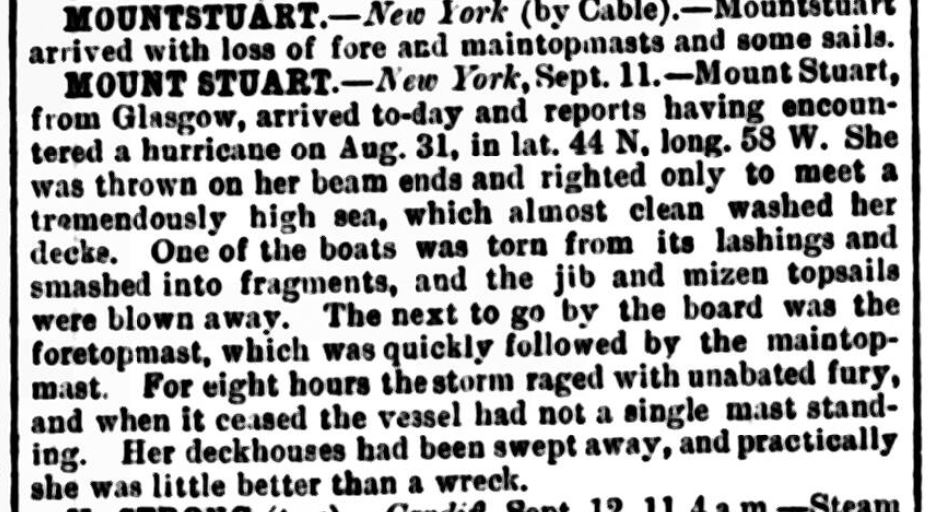
Lloyd’s list account of Mountstuart’s near loss in 1890. Source: BNA
James Hunter moved up the street to rent the house at 24 Princes Square from around 1885 to 1887. After that he moved to 35 (now 25) Queen Square. The partnership with John Sheriff appeared to disolve after 1891 though he remained in business alone until his death in Queen Square on 11 April 1901. His son Allan continued in the timber business.
William Wilson & family c1891-1901
William Wilson was born in Paisley and married Martha Reid of Dalry in 1856. The couple had eight children. In 1852, at the age of only 21, he founded William Wilson & Co, and set up the Lilybank Boiler Works.
A search of the internet finds the Lilybank Boiler Works in the East End of Glasgow, initially on a greenfield site, but later surrounded by 1930s council housing. The Wikipedia page for Lilybank describes the neighbourhood south of Parkhead that took its name from the works. An aerial view taken in 1951 even shows the railway spur to the works passing across the road and through the back courts of the council houses. The firm was taken over by John Thompson in the 1930s and survived into the 1970s, but both the works and the council housing have since been swept away and replaced by a 1990s housing estate .

Wilson Boilermakers at Lilybank seen from the air in 1929. Source: Canmore
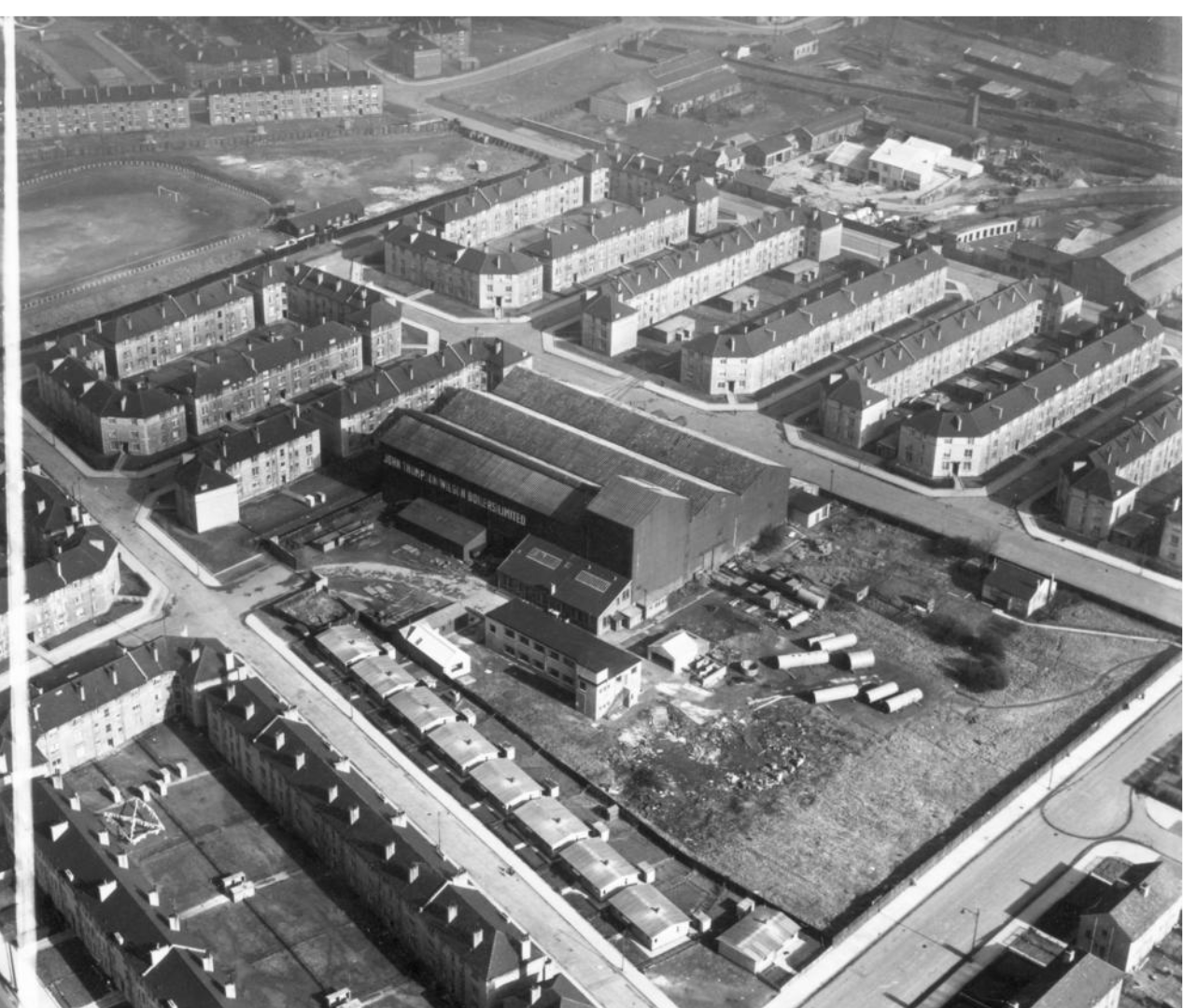
A similar view of John Thompson (Wilson Boilers) Ltd in 1951. Note the new council housing, and the rail line running through the back courts behind the factory. Source: Canmore
However as any Sou’sider historian would know, Lilybank was originally the area adjacent to Eglinton Toll, site of Lilybank Road (no more) with its brickworks and the Etna Foundry, and later the gasometers, and that’s how the works got their name; Wilson’s original factory was on the gushet between Eglinton Street and Pollokshaws Road, just behind the toll house . The toll house was later replaced by the tenement that houses the Star Bar.
The boilerworks didn’t get off to a great start – on the night of 6-7 February 1856 the great hurricane that devastated Glasgow ripped the roof off and demolished part of the building . The same storm blew the steeple of the first Strathbungo Parish Church through its roof. In 1861 Wilson and his family were living in a house on the site, 258 Pollokshaws Road, with the presumably repaired factory behind it.
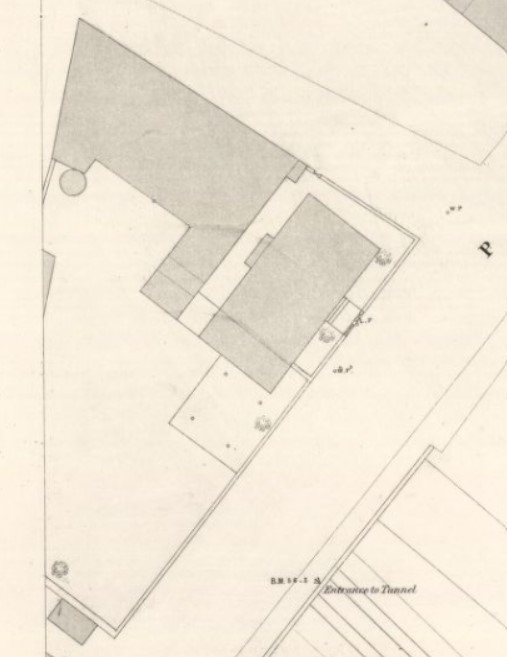
OS Map of 1858 showing the house on Pollokshaws Road and factory behind. The old Eglinton Toll building is just off the map, bottom left. Source: NLS Maps
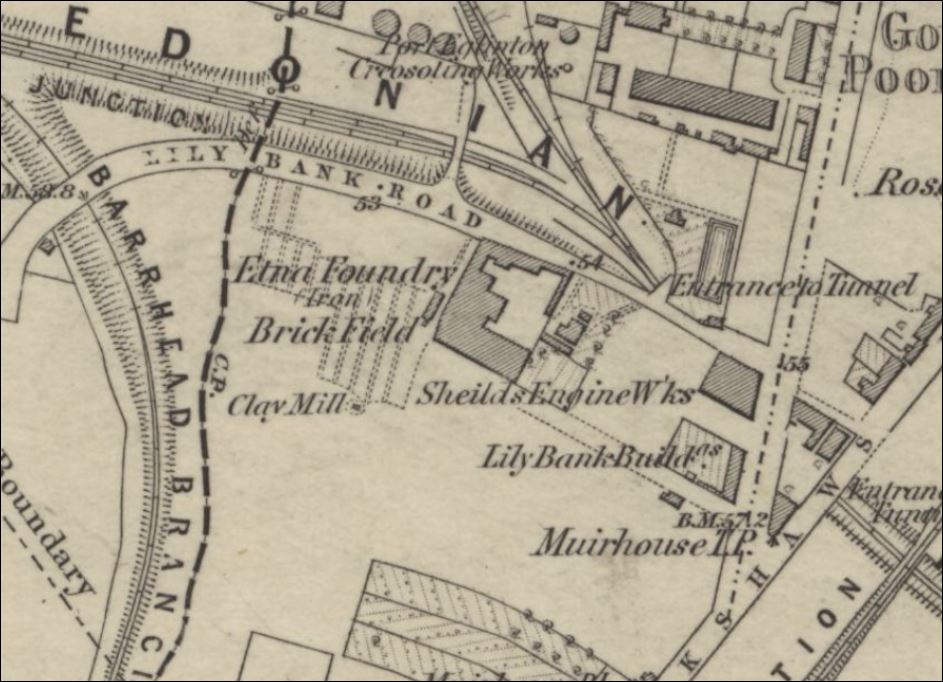
Wider map showing the Toll House gushet (marked Muirhouse Turnpike), house and boilerworks behind (on the right), and Lilybank Road & works on the other side of Eglinton Street. What is now Gourock Street behind the works was also once Lilybank Road. Note also the railway line passing under the factory. Source: NLS Maps
The house was presumably demolished as the factory expanded to fill the entire site. The family moved to Dowanhill, before settling in Strathbungo around 1891. Although Martha and three of their children were at home in Strathbungo on the night of the 1891 census, William was absent. I located him with his two eldest sons, James and William, taking a break at Seamill Hydropathic Hotel in West Kilbride. This might have been an attempt to improve his health, but he died at home two years later on 6 Sep 1893.
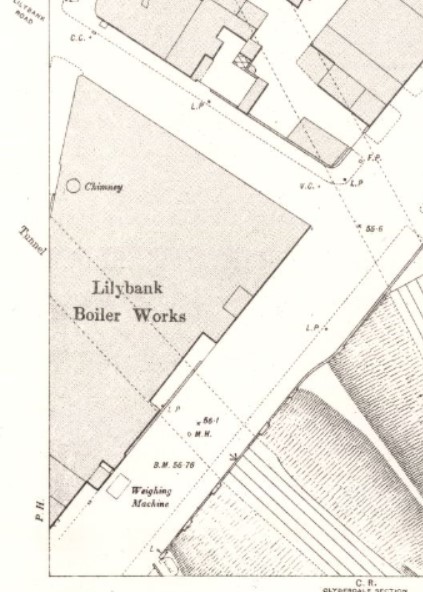
1895 OS Map shows the Lilybank works now occupying the entire site behind the Eglinton Toll. Lilybank (now Gourock) Street lies to the north-east, running between Pollokshaws Road and Eglinton Street (off map to the west) and Pollokshaws Road to the south east. Source: NLS Maps
Subsequently William Joseph Wilson took over the boiler-making and moved out of the house to Newlands. It was presumably he who moved the factory to the East End. His brother James founded Wilson & Co, export merchants and continued to operate from the Eglinton Toll premises initially, though he also remained with the boiler-making. He remained in Princes Square with his mother until after 1901. They later moved to Langside Road (now Drive) in Newlands, close to William, and she died there in 1918.
Here’s a glowing account of Wilson’s boilers from that over-the-top 1891 trade directory :
Messrs. Wm. Wilson & Co., Lilybank Boiler Works, Eglinton Street, Lilybank Road, and Pollokshaws Road.—
There are few industries in the Scottish commercial metropolis which have received better or more creditable development of late years than that of boiler-making ; and prominent among the great representative firms of Glasgow engaged in this highly important department of constructive manufacture stands that of Messrs. William Wilson & Co., controlling the well-known Lilybank Boiler Works. This notable house was founded in 1852 by its present principal, Mr. William Wilson, and its industry has from the first been centred at the present location. The works here occupy a triangular area of ground about 2,500 square yards in superficial extent, and constitute one of the largest and most important centres of the boiler-making industry in or near Glasgow.
Messrs. Wilson are very extensive makers of Cornish, Lancashire, Adamson, Galloway, multitubular, and every other type of boilers in iron or steel, and have developed a special feature in land boilers of all classes. Within the last four years they have laid down at the Lilybank Works a complete plant of new machinery, a step necessitated by the introduction of steel into the construction of steam boilers, and in connection with the same they brought out machinery for drilling instead of punching the rivet-holes in the plates. By this new method, which has entirely superseded the punching process at Lilybank, Messrs. Wilson are enabled to get a considerably cleaner and truer hole.
Among the other improvements now embodied in their productions, in the matter of actual construction, are the planing of the edges of plates, and the boring out of Galloway tube-holes in flues and flue-holes, also turning the edges of end-plates, together with many other noteworthy points and features in manufacture, all accomplished by the most perfect machinery, and all tending in some measure to enhance the worth of the completed boiler. All boilers are tested and guaranteed sound and tight at double their working pressure, and are mounted complete to the requirements of the boiler insurance companies.
Messrs. Wilson have supplied some of the most important works in Scotland, and in the East and West Indies, &c., with boilers of all kinds and descriptions, and have at present a set of boilers, with all the latest improvements, at 110 lbs. working pressure, used in driving the heavy machinery at the Glasgow International Exhibition. The firm, who employ about fifty hands, have an international reputation as boiler-makers, and their productions are known, esteemed, and in constant use in practically every quarter of the globe.
The works at Lilybank are conducted under the personal supervision of Mr. Wm. Wilson himself, ably assisted by one of his sons, who, like his father, is possessed of a thorough practical acquaintance with every detail of the industry ; and the excellent facilities and improved appliances at command are turned to the best and fullest account by the greatest care and precaution being taken to produce the most satisfactory and perfect boilers that can be constructed by the combined efforts of skilled manual labour and the best mechanical service.

Eglinton Toll postcard, perhaps 1919. The Wilson chimney is still visible to the left (rear) of the gushet building though the boilermaking was long gone. Full image at tour-scotland-photographs.blogspot.com
The Virtual Mitchell collection has images of Malcolm & Allen’s Eglinton Garage being demolished in 1934. This may be the boilerworks building re-purposed though I can’t be certain.
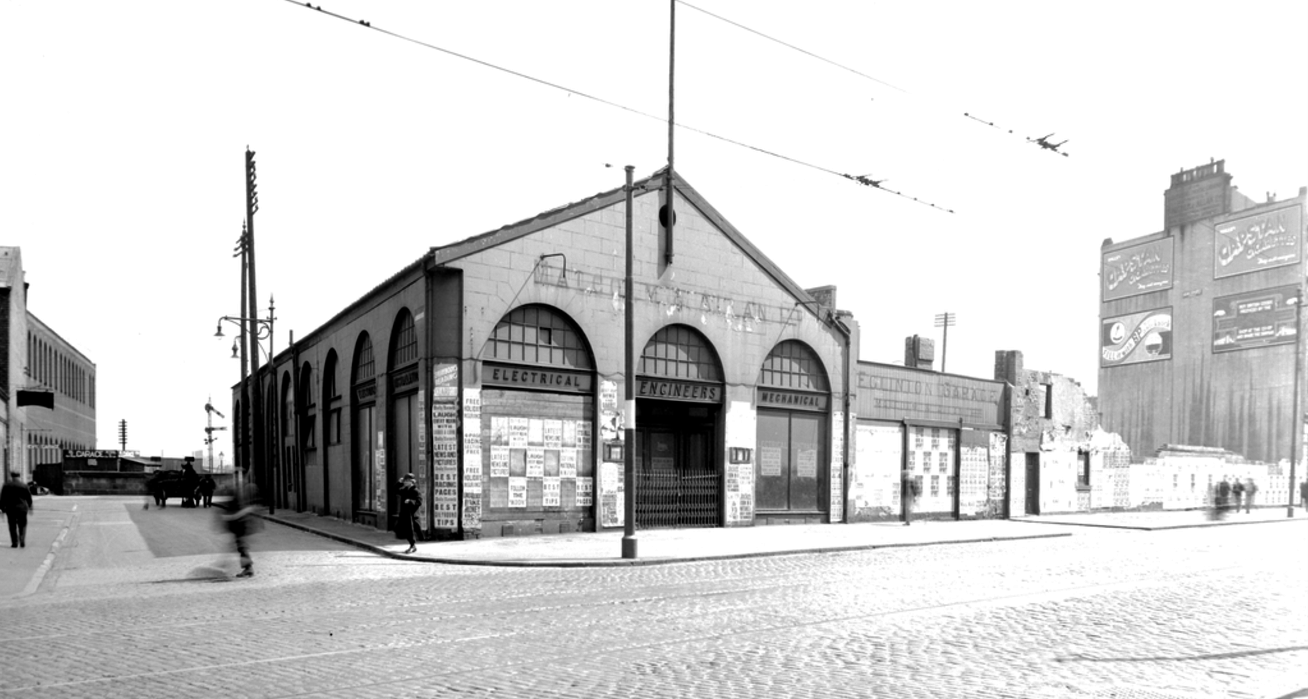
The boarded up former Malcolm & Allan garage facing Eglinton Street, 1934. The gable end of the Star Bar tenement is on the right. Oddly the Mitchell has another view of it in better days, yet dated 1938! Source: Glasgow City Archives C5986
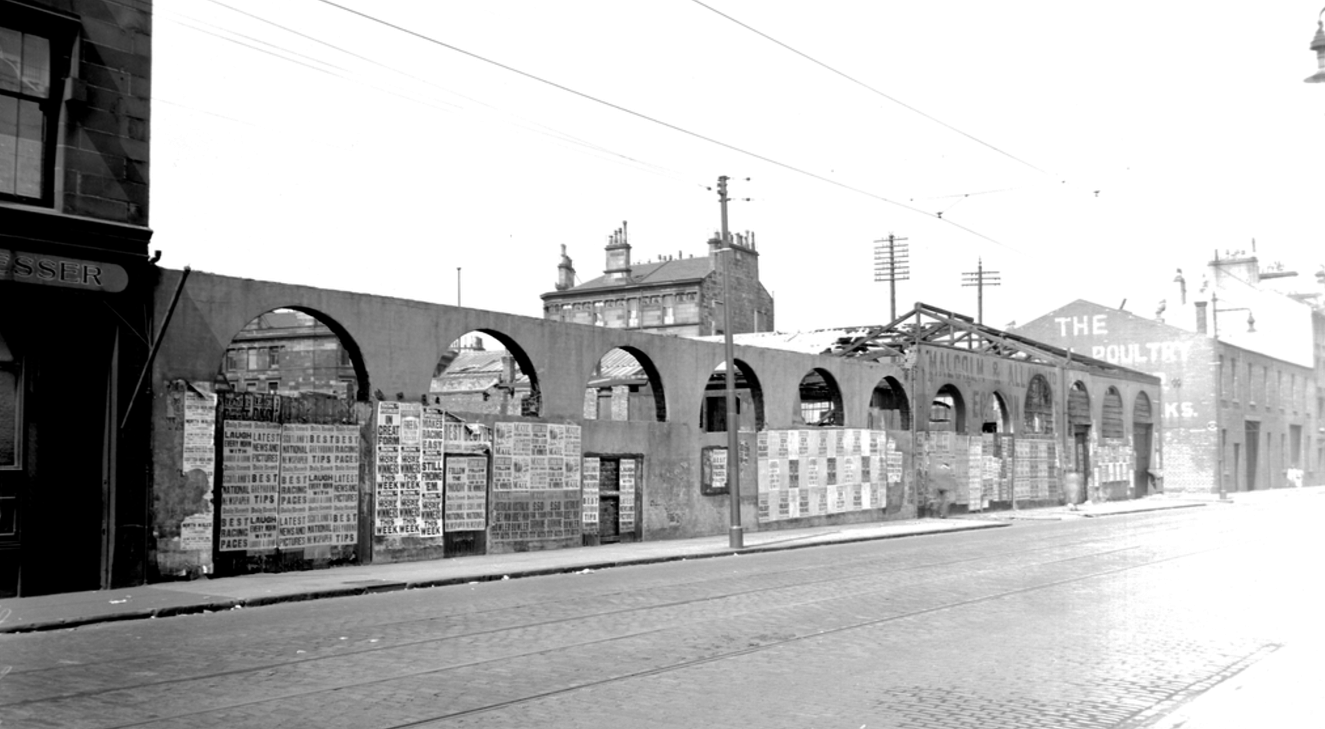
The Pollokshaws Road facade, partly demolished, 1934. Source: Glasgow City Archives C5987
I think another garage was built on the site, but that took has gone and it’s now occupied by P Lipton Memorials.
Robert Gallacher c1901-1911
Robert Gallacher was born in 1845 in Greenock to another Robert Gallacher, a fish salesman from Ireland, and Janet McKenzie from Glasgow. Father Robert moved his business to Glasgow and in 1858 the Glasgow Courier reported how Robert Senior, seller of dried fish and butter in Cowcaddens, was fined 20s for using light weights .
Robert Junior followed his father into the fish business. In 1872 he married Agnes Smith Stirling of Ardrossan, and she gave him eight daughters and finally after a seven-year gap, one son. The family settled in Abbotsford Place in the Gorbals, then a fairly desirable address, but like so many others in Abbotsford Place, including the Buchanans before him, moved out to Strathbungo. They settled at 29 (now 11) Queen Square around 1891. The family remained there for 10 years, although in the 1901 census Agnes was at home while Robert and four of his daughters were staying at 7 Royal Terrace in Rothesay. Soon after the family moved from Queen Square to 24 Princes Square, the house’s ownership being listed in Agnes’ name.
Robert died in 1911, leaving £12,000, but his wife and daughters lived on at 24 Princes Square for some years. She was a teacher, as were several of her daughters.
Robert’s business, William McLachlan & Co
Tracking Robert’s business interests was tricky, but aided once again by that 1891 trade directory which provided some elusive details .
Robert was a partner in the firm of William Mclachlan & Co, with Mr McLachlan himself, the company having been founded in 1872. They were based mainly in The Bridgegate, in or adjacent to the old covered Briggait Fishmarket. They were wholesalers, fish curers and auctioneers, and also dealt in game. They brought in fish from the West of Scotland on their own ships and by rail.
One such ship was the steamer SS Kenilworth, built for the firm by Scott & Co of Bowling in 1885 . It came to a sticky end off Aberdeen in 1906, though long after McLachlan & Co had sold her on .
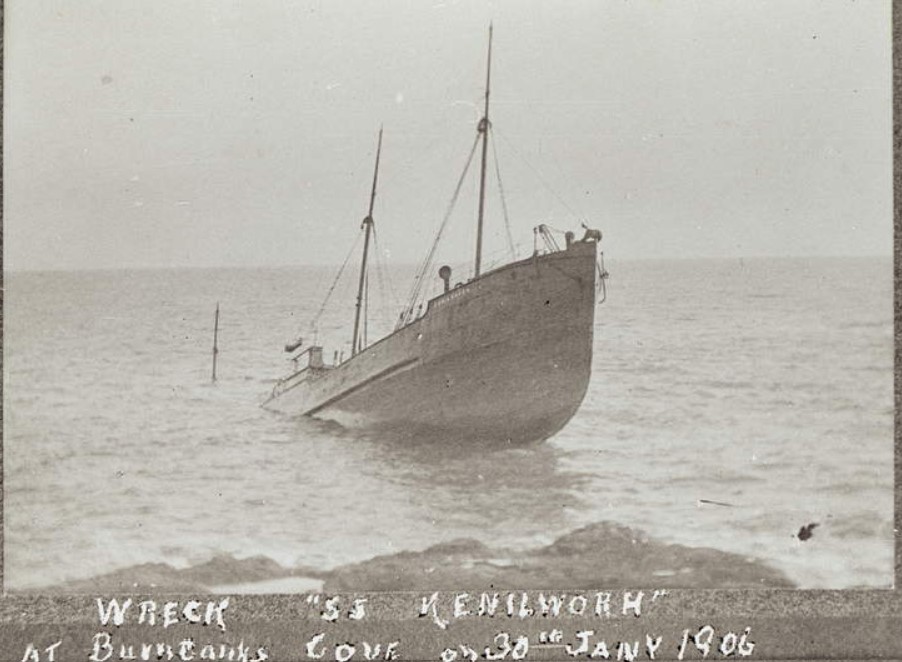
The wreck of the SS Kenilworth at Burnbanks, 30 Jan 1906. Source: Aberdeen City Libraries
Ice making
They also began ice manufacturing from a building at 628 Eglinton Street, a site also used by Boyd’s cooperage, making herring barrels. Ice was a major industry in the 19th century, based on the cutting of ice from frozen lakes in NE America and Scandinavia, and transporting it large distances. The manufacturing of ice on site was a new phenomenon in the 1880s using new ammonia-based refrigeration systems, so making ice from Loch Katrine water would have been a fairly novel undertaking – though they were not the only Glasgow firm doing so. Ice enabled the packing and transport of fresh fish, but was also used for ice cream manufacture, cooling drinks and so forth. The Mclachlans disappeared from Eglinton Street around 1900 but continued as fish and ice merchants in Bridgegate, and ice-making in Logan Street. William died in 1897, and Robert appears to have retired during the 1900s, with William’s son (also William) continuing the business.
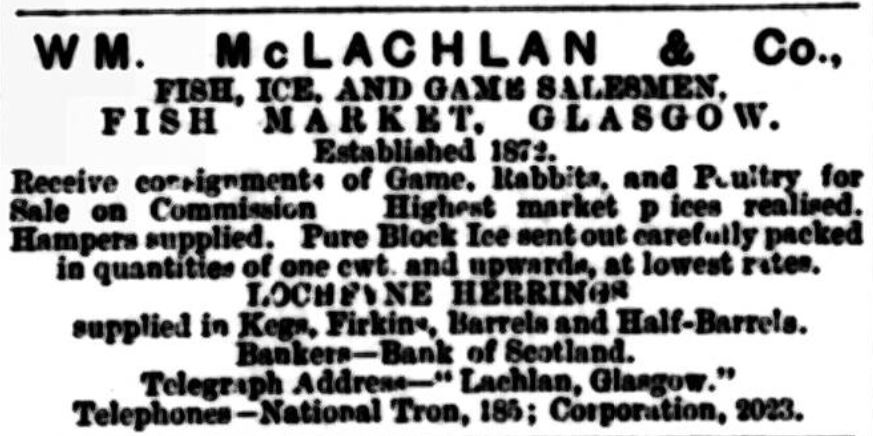
Advert for Wm McLachlan & Co from Montrose Standard 1906. Source: BNA
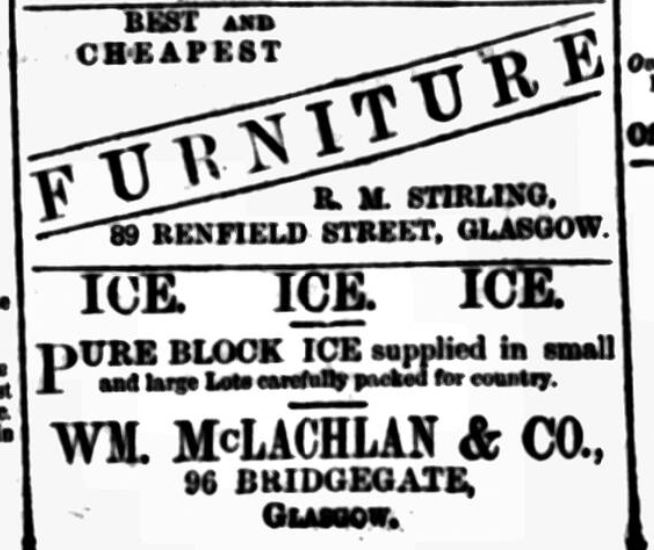
1898 Coatbridge Express advert for McLachlan Ice by chance appears below that for his neighbour at 52 Marywood Square, Robert Stirling. Source: BNA
One curious observation is that the Gallachers bought 24 Princes Square from the Wilsons of Lilybank Boiler Works. The ice factory was at Eglinton Toll, directly across the road from the boiler works (its now a vacant site used as a car wash). Given the Gallachers were also living in Queen Square, the Wilsons and Gallachers were most likely well acquainted.
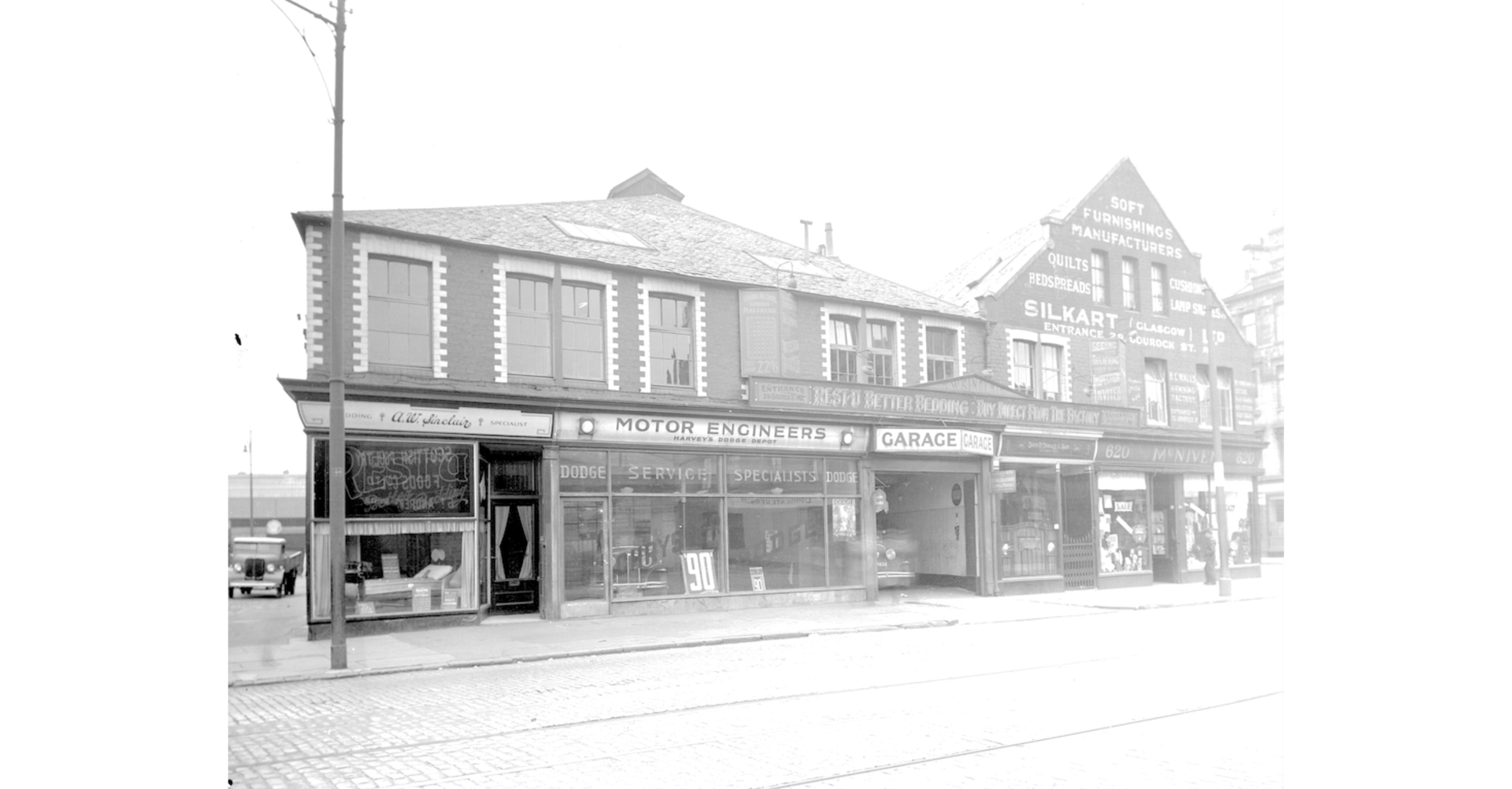
628 Eglinton Street in 1935 as AW Sinclair Bedding (on the left). This was the building that housed the McLachlan & Co ice making factory, and sat directly opposite the Lilybank boilerworks. Source: Glasgow City Archives C5996
Another curiosity was the absence of Robert in the 1881 census. He was visiting friends in Hastings, Sussex. The friends were his partner William McLachlan and his family, though what they were doing living in Hastings at the time remains a mystery. Despite his business in Glasgow, William was actually from Edinburgh, usually lived there, and died there .
Wm. McLachlan & Co., Fish Merchants and Ice Manufacturers, 96, Bridgegate, and 628, Eglinton Street, Glasgow.
Amongst the many purveyors of that very necessary and nutritious article of diet — fish — the firm of Wm. McLachlan & Co., of 96, Bridgegate, and 628, Eglinton Street, holds a prominent place. The business is an old one, having been established twenty ago by the present proprietors, Messrs. Wm. McLachlan and Robert Gallacher, to whose joint exertions must be attributed the success which has attended their undertaking since its foundation.
They draw their supplies, consisting of herring and all other kinds of fish, from Loch Fyne and the north-west of Scotland, which are brought to Glasgow and other Scotch railway stations by their own steamers, where they are distributed over all the important towns in the Kingdom, and the greatest care is taken that only the freshest and most perfectly wholesome are offered for sale, thus ensuring from their influential clientele a hearty and deserving patronage. Messrs. McLachlan and Co. have a stand in the market which gives them greater advantages for the display of their fine stock and a wider field for their operations, it being used principally for carrying on auction sales of all kinds of fresh and smoked fish, including kippered herrings, which are cured by themselves in their own curing houses.
Their labours, however, are not exclusively confined to the piscatorial line, for, encouraged perhaps by their success in that direction, they have lately started an Ice manufacturing business at their Eglinton Street establishment, where they have very extensive and valuable plant of the most modern and improved style in use for the various processes of manufacture. The water required for this branch of their business is brought from Loch Katrine and is made up into blocks ; the large quantity of one hundred and twenty tons being produced weekly. They have a very great demand for this commodity, it being largely used by ice-cream manufacturers, for table and preserving purposes, fish, beef, etc.
A staff of eighty hands is employed to carry on these combined businesses, which, being under the personal control of one or other of the proprietors, are managed in a thoroughly practical and satisfactory manner.
The company was only wound up in 1959 .
Agnes Gallacher c1901-1920
The Gallachers were a catholic family, and Agnes made the odd appearance in the press.
In June 1908 Robert & Agnes’ daughter Jessie married Dr Michael McLaughlin at Holy Cross RC Church in Daisy Street, Govanhill. Agnes then entertained 80 guests at the reception back at the house. The wedding got quite a write-up in the Derry Journal .
In 1913 Agnes replied to a letter in the East of Fife Record from a Mrs Rothwell. While agreeing with the premise that women suffered injustices under laws that favoured men, she took issue with the line “If the father is an atheist or Roman Catholic, an idler or drunkard, the mother must submit, or defeat him by guile in the rearing of the children.” Rising to the defence of Catholicism she reminded Mrs Rothwell that “…courtesy and fairness will do more for the cause she has at heart than bigoted misrepresentation.” She does however somewhat undermine her argument against bigotry when she asks that the Catholic father should not be classed alongside atheists as lawless parents. Protestants and Catholics should unite against atheists? Different times, I suppose .
Agnes died at 23 Doune Terrace, Kelvinside in Nov 1925 and her final appearance was her obituary . It describes her charitable work and her prominence in the “little Catholic circle which flourished in Strathbungo thirty or fourty years ago…the Raffertys, Gallachers, Boyles, Stromiers, Lochranes and others…parishioners of Holy Cross when the mission was established.”
John W McLusky c1920-1930
John McLusky was the senior gas engineer in Airdrie, and then Blackburn. In 1920 he was appointed as engineer and general manager of the gas department of Glasgow Corporation, a post he held at least into the 1940s. He arrived in time to supervise the completion of a major overhaul of the Provan gasworks, although their famous gasometers beside the M8 predate him (c 1904). He later moved out to Whitecraigs.
Bedsit land
Thereafter there are no residents recorded in the PO Directories, though in 1934 there was an advert in the Scotsman for permanent or visiting boarders. The valuation roll of 1940 records the owner as Service Flats (Glasgow) Ltd (proprietor Margaret Barnett), and there were a caretaker and six other unrelated tenants, perhaps a reflection of Strathbungo’s descent into bedsits in the mid twentieth century.
The property currently exists as four flats.
Additions and corrections welcome.
References
{3557955:Y5GUQI7L},{3557955:TTWSP94R};{3557955:JR4DKZB5};{3557955:KASVSAEU},{3557955:B4J67WP3};{3557955:5B4R6PK9};{3557955:NYBGBBZA},{3557955:9G5785FS};{3557955:TTWSP94R};{3557955:SSJXMXNR};{3557955:UDYEAN2X},{3557955:TTWSP94R};{3557955:QAJLGJCP};{3557955:ZULG5RPH};{3557955:E8ZYDNCC};{3557955:JCKPMXEE};{3557955:8UKFG6B5};{3557955:WIEKYEMM};{3557955:N27GN5RH}
vancouver
asc
0
5137
%7B%22status%22%3A%22success%22%2C%22updateneeded%22%3Afalse%2C%22instance%22%3A%22zotpress-d466b6fa379144652a6ee75807b91a93%22%2C%22meta%22%3A%7B%22request_last%22%3A0%2C%22request_next%22%3A0%2C%22used_cache%22%3Atrue%7D%2C%22data%22%3A%5B%7B%22key%22%3A%22JCKPMXEE%22%2C%22library%22%3A%7B%22id%22%3A3557955%7D%2C%22meta%22%3A%7B%22parsedDate%22%3A%221959-09-25%22%2C%22numChildren%22%3A1%7D%2C%22bib%22%3A%22%3Cdiv%20class%3D%5C%22csl-bib-body%5C%22%20style%3D%5C%22line-height%3A%201.35%3B%20%5C%22%3E%5Cn%20%20%3Cdiv%20class%3D%5C%22csl-entry%5C%22%20style%3D%5C%22clear%3A%20left%3B%20%5C%22%3E%5Cn%20%20%20%20%3Cdiv%20class%3D%5C%22csl-left-margin%5C%22%20style%3D%5C%22float%3A%20left%3B%20padding-right%3A%200.5em%3B%20text-align%3A%20right%3B%20width%3A%201em%3B%5C%22%3E1.%3C%5C%2Fdiv%3E%3Cdiv%20class%3D%5C%22csl-right-inline%5C%22%20style%3D%5C%22margin%3A%200%20.4em%200%201.5em%3B%5C%22%3EWilliam%20McLachlan%20%26amp%3B%20Company%20Limited.%20The%20Edinburgh%20Gazette.%201959%20Sep%2025%3B%3C%5C%2Fdiv%3E%5Cn%20%20%20%3C%5C%2Fdiv%3E%5Cn%3C%5C%2Fdiv%3E%22%2C%22data%22%3A%7B%22itemType%22%3A%22newspaperArticle%22%2C%22title%22%3A%22William%20McLachlan%20%26%20Company%20Limited%22%2C%22creators%22%3A%5B%5D%2C%22abstractNote%22%3A%22%22%2C%22date%22%3A%2225%20Sep%201959%22%2C%22section%22%3A%22%22%2C%22language%22%3A%22en%22%2C%22ISSN%22%3A%22%22%2C%22url%22%3A%22%22%2C%22collections%22%3A%5B%22CAR6MXPM%22%5D%2C%22dateModified%22%3A%222025-01-10T12%3A40%3A37Z%22%7D%7D%2C%7B%22key%22%3A%22SSJXMXNR%22%2C%22library%22%3A%7B%22id%22%3A3557955%7D%2C%22meta%22%3A%7B%22parsedDate%22%3A%221858-07-31%22%2C%22numChildren%22%3A1%7D%2C%22bib%22%3A%22%3Cdiv%20class%3D%5C%22csl-bib-body%5C%22%20style%3D%5C%22line-height%3A%201.35%3B%20%5C%22%3E%5Cn%20%20%3Cdiv%20class%3D%5C%22csl-entry%5C%22%20style%3D%5C%22clear%3A%20left%3B%20%5C%22%3E%5Cn%20%20%20%20%3Cdiv%20class%3D%5C%22csl-left-margin%5C%22%20style%3D%5C%22float%3A%20left%3B%20padding-right%3A%200.5em%3B%20text-align%3A%20right%3B%20width%3A%201em%3B%5C%22%3E1.%3C%5C%2Fdiv%3E%3Cdiv%20class%3D%5C%22csl-right-inline%5C%22%20style%3D%5C%22margin%3A%200%20.4em%200%201.5em%3B%5C%22%3EWeights%20and%20Measures.%20Glasgow%20Courier%20%5BInternet%5D.%201858%20Jul%2031%20%5Bcited%202025%20Jan%207%5D%3B%20Available%20from%3A%20%3Ca%20href%3D%27https%3A%5C%2F%5C%2Fwww.britishnewspaperarchive.co.uk%5C%2Fviewer%5C%2Fbl%5C%2F0003089%5C%2F18580731%5C%2F066%5C%2F0004%27%3Ehttps%3A%5C%2F%5C%2Fwww.britishnewspaperarchive.co.uk%5C%2Fviewer%5C%2Fbl%5C%2F0003089%5C%2F18580731%5C%2F066%5C%2F0004%3C%5C%2Fa%3E%3C%5C%2Fdiv%3E%5Cn%20%20%3C%5C%2Fdiv%3E%5Cn%3C%5C%2Fdiv%3E%22%2C%22data%22%3A%7B%22itemType%22%3A%22newspaperArticle%22%2C%22title%22%3A%22Weights%20and%20Measures%22%2C%22creators%22%3A%5B%5D%2C%22abstractNote%22%3A%22%22%2C%22date%22%3A%2231%20Jul%201858%22%2C%22section%22%3A%22%22%2C%22language%22%3A%22%22%2C%22ISSN%22%3A%22%22%2C%22url%22%3A%22https%3A%5C%2F%5C%2Fwww.britishnewspaperarchive.co.uk%5C%2Fviewer%5C%2Fbl%5C%2F0003089%5C%2F18580731%5C%2F066%5C%2F0004%22%2C%22collections%22%3A%5B%22CAR6MXPM%22%5D%2C%22dateModified%22%3A%222025-01-07T22%3A39%3A48Z%22%7D%7D%2C%7B%22key%22%3A%22JR4DKZB5%22%2C%22library%22%3A%7B%22id%22%3A3557955%7D%2C%22meta%22%3A%7B%22parsedDate%22%3A%221890-09-12%22%2C%22numChildren%22%3A1%7D%2C%22bib%22%3A%22%3Cdiv%20class%3D%5C%22csl-bib-body%5C%22%20style%3D%5C%22line-height%3A%201.35%3B%20%5C%22%3E%5Cn%20%20%3Cdiv%20class%3D%5C%22csl-entry%5C%22%20style%3D%5C%22clear%3A%20left%3B%20%5C%22%3E%5Cn%20%20%20%20%3Cdiv%20class%3D%5C%22csl-left-margin%5C%22%20style%3D%5C%22float%3A%20left%3B%20padding-right%3A%200.5em%3B%20text-align%3A%20right%3B%20width%3A%201em%3B%5C%22%3E1.%3C%5C%2Fdiv%3E%3Cdiv%20class%3D%5C%22csl-right-inline%5C%22%20style%3D%5C%22margin%3A%200%20.4em%200%201.5em%3B%5C%22%3ETo%20Correspondents.%20Lloyd%26%23x2019%3Bs%20List%20%5BInternet%5D.%201890%20Sep%2012%20%5Bcited%202025%20Jan%207%5D%3B%20Available%20from%3A%20%3Ca%20href%3D%27https%3A%5C%2F%5C%2Fwww.britishnewspaperarchive.co.uk%5C%2Fviewer%5C%2Fbl%5C%2F0001941%5C%2F18900912%5C%2F099%5C%2F0008%27%3Ehttps%3A%5C%2F%5C%2Fwww.britishnewspaperarchive.co.uk%5C%2Fviewer%5C%2Fbl%5C%2F0001941%5C%2F18900912%5C%2F099%5C%2F0008%3C%5C%2Fa%3E%3C%5C%2Fdiv%3E%5Cn%20%20%3C%5C%2Fdiv%3E%5Cn%3C%5C%2Fdiv%3E%22%2C%22data%22%3A%7B%22itemType%22%3A%22newspaperArticle%22%2C%22title%22%3A%22To%20Correspondents%22%2C%22creators%22%3A%5B%5D%2C%22abstractNote%22%3A%22%22%2C%22date%22%3A%2212%20Sep%201890%22%2C%22section%22%3A%22%22%2C%22language%22%3A%22%22%2C%22ISSN%22%3A%22%22%2C%22url%22%3A%22https%3A%5C%2F%5C%2Fwww.britishnewspaperarchive.co.uk%5C%2Fviewer%5C%2Fbl%5C%2F0001941%5C%2F18900912%5C%2F099%5C%2F0008%22%2C%22collections%22%3A%5B%22CAR6MXPM%22%5D%2C%22dateModified%22%3A%222025-01-07T21%3A58%3A46Z%22%7D%7D%2C%7B%22key%22%3A%22NYBGBBZA%22%2C%22library%22%3A%7B%22id%22%3A3557955%7D%2C%22meta%22%3A%7B%22parsedDate%22%3A%221856-02-08%22%2C%22numChildren%22%3A1%7D%2C%22bib%22%3A%22%3Cdiv%20class%3D%5C%22csl-bib-body%5C%22%20style%3D%5C%22line-height%3A%201.35%3B%20%5C%22%3E%5Cn%20%20%3Cdiv%20class%3D%5C%22csl-entry%5C%22%20style%3D%5C%22clear%3A%20left%3B%20%5C%22%3E%5Cn%20%20%20%20%3Cdiv%20class%3D%5C%22csl-left-margin%5C%22%20style%3D%5C%22float%3A%20left%3B%20padding-right%3A%200.5em%3B%20text-align%3A%20right%3B%20width%3A%201em%3B%5C%22%3E1.%3C%5C%2Fdiv%3E%3Cdiv%20class%3D%5C%22csl-right-inline%5C%22%20style%3D%5C%22margin%3A%200%20.4em%200%201.5em%3B%5C%22%3EFearful%20Hurricane.%20North%20British%20Daily%20Mail%20%5BInternet%5D.%201856%20Feb%208%20%5Bcited%202025%20Jan%207%5D%3B%20Available%20from%3A%20%3Ca%20href%3D%27https%3A%5C%2F%5C%2Fwww.britishnewspaperarchive.co.uk%5C%2Fviewer%5C%2Fbl%5C%2F0002683%5C%2F18560208%5C%2F011%5C%2F0002%27%3Ehttps%3A%5C%2F%5C%2Fwww.britishnewspaperarchive.co.uk%5C%2Fviewer%5C%2Fbl%5C%2F0002683%5C%2F18560208%5C%2F011%5C%2F0002%3C%5C%2Fa%3E%3C%5C%2Fdiv%3E%5Cn%20%20%3C%5C%2Fdiv%3E%5Cn%3C%5C%2Fdiv%3E%22%2C%22data%22%3A%7B%22itemType%22%3A%22newspaperArticle%22%2C%22title%22%3A%22Fearful%20Hurricane%22%2C%22creators%22%3A%5B%5D%2C%22abstractNote%22%3A%22%22%2C%22date%22%3A%228%20Feb%201856%22%2C%22section%22%3A%22%22%2C%22language%22%3A%22%22%2C%22ISSN%22%3A%22%22%2C%22url%22%3A%22https%3A%5C%2F%5C%2Fwww.britishnewspaperarchive.co.uk%5C%2Fviewer%5C%2Fbl%5C%2F0002683%5C%2F18560208%5C%2F011%5C%2F0002%22%2C%22collections%22%3A%5B%22CAR6MXPM%22%5D%2C%22dateModified%22%3A%222025-01-07T16%3A42%3A31Z%22%7D%7D%2C%7B%22key%22%3A%229G5785FS%22%2C%22library%22%3A%7B%22id%22%3A3557955%7D%2C%22meta%22%3A%7B%22parsedDate%22%3A%221856-02-09%22%2C%22numChildren%22%3A1%7D%2C%22bib%22%3A%22%3Cdiv%20class%3D%5C%22csl-bib-body%5C%22%20style%3D%5C%22line-height%3A%201.35%3B%20%5C%22%3E%5Cn%20%20%3Cdiv%20class%3D%5C%22csl-entry%5C%22%20style%3D%5C%22clear%3A%20left%3B%20%5C%22%3E%5Cn%20%20%20%20%3Cdiv%20class%3D%5C%22csl-left-margin%5C%22%20style%3D%5C%22float%3A%20left%3B%20padding-right%3A%200.5em%3B%20text-align%3A%20right%3B%20width%3A%201em%3B%5C%22%3E1.%3C%5C%2Fdiv%3E%3Cdiv%20class%3D%5C%22csl-right-inline%5C%22%20style%3D%5C%22margin%3A%200%20.4em%200%201.5em%3B%5C%22%3EFrightful%20Hurricane.%20Loss%20Of%20Life%20and%20Destruction%20Of%20Property.%20Glasgow%20Courier%20%5BInternet%5D.%201856%20Feb%209%20%5Bcited%202025%20Jan%207%5D%3B%20Available%20from%3A%20%3Ca%20href%3D%27https%3A%5C%2F%5C%2Fwww.britishnewspaperarchive.co.uk%5C%2Fviewer%5C%2Fbl%5C%2F0003089%5C%2F18560209%5C%2F010%5C%2F0001%27%3Ehttps%3A%5C%2F%5C%2Fwww.britishnewspaperarchive.co.uk%5C%2Fviewer%5C%2Fbl%5C%2F0003089%5C%2F18560209%5C%2F010%5C%2F0001%3C%5C%2Fa%3E%3C%5C%2Fdiv%3E%5Cn%20%20%3C%5C%2Fdiv%3E%5Cn%3C%5C%2Fdiv%3E%22%2C%22data%22%3A%7B%22itemType%22%3A%22newspaperArticle%22%2C%22title%22%3A%22Frightful%20Hurricane.%20Loss%20Of%20Life%20and%20Destruction%20Of%20Property%22%2C%22creators%22%3A%5B%5D%2C%22abstractNote%22%3A%22%22%2C%22date%22%3A%229%20Feb%201856%22%2C%22section%22%3A%22%22%2C%22language%22%3A%22%22%2C%22ISSN%22%3A%22%22%2C%22url%22%3A%22https%3A%5C%2F%5C%2Fwww.britishnewspaperarchive.co.uk%5C%2Fviewer%5C%2Fbl%5C%2F0003089%5C%2F18560209%5C%2F010%5C%2F0001%22%2C%22collections%22%3A%5B%22CAR6MXPM%22%5D%2C%22dateModified%22%3A%222025-01-07T16%3A41%3A50Z%22%7D%7D%2C%7B%22key%22%3A%22N27GN5RH%22%2C%22library%22%3A%7B%22id%22%3A3557955%7D%2C%22meta%22%3A%7B%22parsedDate%22%3A%221925-11-28%22%2C%22numChildren%22%3A1%7D%2C%22bib%22%3A%22%3Cdiv%20class%3D%5C%22csl-bib-body%5C%22%20style%3D%5C%22line-height%3A%201.35%3B%20%5C%22%3E%5Cn%20%20%3Cdiv%20class%3D%5C%22csl-entry%5C%22%20style%3D%5C%22clear%3A%20left%3B%20%5C%22%3E%5Cn%20%20%20%20%3Cdiv%20class%3D%5C%22csl-left-margin%5C%22%20style%3D%5C%22float%3A%20left%3B%20padding-right%3A%200.5em%3B%20text-align%3A%20right%3B%20width%3A%201em%3B%5C%22%3E1.%3C%5C%2Fdiv%3E%3Cdiv%20class%3D%5C%22csl-right-inline%5C%22%20style%3D%5C%22margin%3A%200%20.4em%200%201.5em%3B%5C%22%3EObituary.%20Glasgow%20Observer%20and%20Catholic%20Herald%20%5BInternet%5D.%201925%20Nov%2028%20%5Bcited%202025%20Jan%206%5D%3B%20Available%20from%3A%20%3Ca%20href%3D%27https%3A%5C%2F%5C%2Fwww.britishnewspaperarchive.co.uk%5C%2Fviewer%5C%2Fbl%5C%2F0001843%5C%2F19251128%5C%2F058%5C%2F0004%27%3Ehttps%3A%5C%2F%5C%2Fwww.britishnewspaperarchive.co.uk%5C%2Fviewer%5C%2Fbl%5C%2F0001843%5C%2F19251128%5C%2F058%5C%2F0004%3C%5C%2Fa%3E%3C%5C%2Fdiv%3E%5Cn%20%20%3C%5C%2Fdiv%3E%5Cn%3C%5C%2Fdiv%3E%22%2C%22data%22%3A%7B%22itemType%22%3A%22newspaperArticle%22%2C%22title%22%3A%22Obituary%22%2C%22creators%22%3A%5B%5D%2C%22abstractNote%22%3A%22%22%2C%22date%22%3A%2228%20Nov%201925%22%2C%22section%22%3A%22%22%2C%22language%22%3A%22%22%2C%22ISSN%22%3A%22%22%2C%22url%22%3A%22https%3A%5C%2F%5C%2Fwww.britishnewspaperarchive.co.uk%5C%2Fviewer%5C%2Fbl%5C%2F0001843%5C%2F19251128%5C%2F058%5C%2F0004%22%2C%22collections%22%3A%5B%22CAR6MXPM%22%5D%2C%22dateModified%22%3A%222025-01-06T15%3A11%3A03Z%22%7D%7D%2C%7B%22key%22%3A%22WIEKYEMM%22%2C%22library%22%3A%7B%22id%22%3A3557955%7D%2C%22meta%22%3A%7B%22parsedDate%22%3A%221913-11-20%22%2C%22numChildren%22%3A1%7D%2C%22bib%22%3A%22%3Cdiv%20class%3D%5C%22csl-bib-body%5C%22%20style%3D%5C%22line-height%3A%201.35%3B%20%5C%22%3E%5Cn%20%20%3Cdiv%20class%3D%5C%22csl-entry%5C%22%20style%3D%5C%22clear%3A%20left%3B%20%5C%22%3E%5Cn%20%20%20%20%3Cdiv%20class%3D%5C%22csl-left-margin%5C%22%20style%3D%5C%22float%3A%20left%3B%20padding-right%3A%200.5em%3B%20text-align%3A%20right%3B%20width%3A%201em%3B%5C%22%3E1.%3C%5C%2Fdiv%3E%3Cdiv%20class%3D%5C%22csl-right-inline%5C%22%20style%3D%5C%22margin%3A%200%20.4em%200%201.5em%3B%5C%22%3ELetters%20To%20Editor.%20-%20Under%20Man%26%23x2019%3Bs%20Laws.%20East%20of%20Fife%20Record%20%5BInternet%5D.%201913%20Nov%2020%20%5Bcited%202025%20Jan%206%5D%3B%20Available%20from%3A%20%3Ca%20href%3D%27https%3A%5C%2F%5C%2Fwww.britishnewspaperarchive.co.uk%5C%2Fviewer%5C%2Fbl%5C%2F0002699%5C%2F19131120%5C%2F125%5C%2F0008%27%3Ehttps%3A%5C%2F%5C%2Fwww.britishnewspaperarchive.co.uk%5C%2Fviewer%5C%2Fbl%5C%2F0002699%5C%2F19131120%5C%2F125%5C%2F0008%3C%5C%2Fa%3E%3C%5C%2Fdiv%3E%5Cn%20%20%3C%5C%2Fdiv%3E%5Cn%3C%5C%2Fdiv%3E%22%2C%22data%22%3A%7B%22itemType%22%3A%22newspaperArticle%22%2C%22title%22%3A%22Letters%20To%20Editor.%20-%20Under%20Man%27s%20Laws%22%2C%22creators%22%3A%5B%5D%2C%22abstractNote%22%3A%22%22%2C%22date%22%3A%2220%20Nov%201913%22%2C%22section%22%3A%22%22%2C%22language%22%3A%22%22%2C%22ISSN%22%3A%22%22%2C%22url%22%3A%22https%3A%5C%2F%5C%2Fwww.britishnewspaperarchive.co.uk%5C%2Fviewer%5C%2Fbl%5C%2F0002699%5C%2F19131120%5C%2F125%5C%2F0008%22%2C%22collections%22%3A%5B%22CAR6MXPM%22%5D%2C%22dateModified%22%3A%222025-01-06T15%3A08%3A38Z%22%7D%7D%2C%7B%22key%22%3A%228UKFG6B5%22%2C%22library%22%3A%7B%22id%22%3A3557955%7D%2C%22meta%22%3A%7B%22parsedDate%22%3A%221908-06-19%22%2C%22numChildren%22%3A1%7D%2C%22bib%22%3A%22%3Cdiv%20class%3D%5C%22csl-bib-body%5C%22%20style%3D%5C%22line-height%3A%201.35%3B%20%5C%22%3E%5Cn%20%20%3Cdiv%20class%3D%5C%22csl-entry%5C%22%20style%3D%5C%22clear%3A%20left%3B%20%5C%22%3E%5Cn%20%20%20%20%3Cdiv%20class%3D%5C%22csl-left-margin%5C%22%20style%3D%5C%22float%3A%20left%3B%20padding-right%3A%200.5em%3B%20text-align%3A%20right%3B%20width%3A%201em%3B%5C%22%3E1.%3C%5C%2Fdiv%3E%3Cdiv%20class%3D%5C%22csl-right-inline%5C%22%20style%3D%5C%22margin%3A%200%20.4em%200%201.5em%3B%5C%22%3EMarriage%20McLaughlin-Gallacher.%20Derry%20Journal%20%5BInternet%5D.%201908%20Jun%2019%20%5Bcited%202025%20Jan%206%5D%3B%20Available%20from%3A%20%3Ca%20href%3D%27https%3A%5C%2F%5C%2Fwww.britishnewspaperarchive.co.uk%5C%2Fviewer%5C%2Fbl%5C%2F0001123%5C%2F19080619%5C%2F112%5C%2F0007%27%3Ehttps%3A%5C%2F%5C%2Fwww.britishnewspaperarchive.co.uk%5C%2Fviewer%5C%2Fbl%5C%2F0001123%5C%2F19080619%5C%2F112%5C%2F0007%3C%5C%2Fa%3E%3C%5C%2Fdiv%3E%5Cn%20%20%3C%5C%2Fdiv%3E%5Cn%3C%5C%2Fdiv%3E%22%2C%22data%22%3A%7B%22itemType%22%3A%22newspaperArticle%22%2C%22title%22%3A%22Marriage%20McLaughlin-Gallacher%22%2C%22creators%22%3A%5B%5D%2C%22abstractNote%22%3A%22%22%2C%22date%22%3A%2219%20Jun%201908%22%2C%22section%22%3A%22%22%2C%22language%22%3A%22%22%2C%22ISSN%22%3A%22%22%2C%22url%22%3A%22https%3A%5C%2F%5C%2Fwww.britishnewspaperarchive.co.uk%5C%2Fviewer%5C%2Fbl%5C%2F0001123%5C%2F19080619%5C%2F112%5C%2F0007%22%2C%22collections%22%3A%5B%22CAR6MXPM%22%5D%2C%22dateModified%22%3A%222025-01-06T14%3A35%3A46Z%22%7D%7D%2C%7B%22key%22%3A%22TTWSP94R%22%2C%22library%22%3A%7B%22id%22%3A3557955%7D%2C%22meta%22%3A%7B%22creatorSummary%22%3A%22University%20of%20Guelph%20Library%22%2C%22parsedDate%22%3A%221891%22%2C%22numChildren%22%3A0%7D%2C%22bib%22%3A%22%3Cdiv%20class%3D%5C%22csl-bib-body%5C%22%20style%3D%5C%22line-height%3A%201.35%3B%20%5C%22%3E%5Cn%20%20%3Cdiv%20class%3D%5C%22csl-entry%5C%22%20style%3D%5C%22clear%3A%20left%3B%20%5C%22%3E%5Cn%20%20%20%20%3Cdiv%20class%3D%5C%22csl-left-margin%5C%22%20style%3D%5C%22float%3A%20left%3B%20padding-right%3A%200.5em%3B%20text-align%3A%20right%3B%20width%3A%201em%3B%5C%22%3E1.%3C%5C%2Fdiv%3E%3Cdiv%20class%3D%5C%22csl-right-inline%5C%22%20style%3D%5C%22margin%3A%200%20.4em%200%201.5em%3B%5C%22%3EGlasgow%20and%20Its%20Environs%3B%20a%20Literary%20Commercial%2C%20and%20Social%20Review%20Past%20and%20Present%3B%20With%20a%20Description%20of%20Its%20Leading%20Mercantile%20Houses%20and%20Commercial%20Enterprises%20%5BInternet%5D.%20London%2C%20Stratten%20%26amp%3B%20Stratten%2C%201891%3B%201891%20%5Bcited%202025%20Jan%206%5D.%20378%20p.%20Available%20from%3A%20%3Ca%20href%3D%27http%3A%5C%2F%5C%2Farchive.org%5C%2Fdetails%5C%2Fglasgowitsenviro00unse%27%3Ehttp%3A%5C%2F%5C%2Farchive.org%5C%2Fdetails%5C%2Fglasgowitsenviro00unse%3C%5C%2Fa%3E%3C%5C%2Fdiv%3E%5Cn%20%20%3C%5C%2Fdiv%3E%5Cn%3C%5C%2Fdiv%3E%22%2C%22data%22%3A%7B%22itemType%22%3A%22book%22%2C%22title%22%3A%22Glasgow%20and%20Its%20Environs%3B%20a%20Literary%20Commercial%2C%20and%20Social%20Review%20Past%20and%20Present%3B%20With%20a%20Description%20of%20Its%20Leading%20Mercantile%20Houses%20and%20Commercial%20Enterprises%22%2C%22creators%22%3A%5B%7B%22creatorType%22%3A%22contributor%22%2C%22name%22%3A%22University%20of%20Guelph%20Library%22%7D%5D%2C%22abstractNote%22%3A%22358%20P.%20Illus%22%2C%22date%22%3A%221891%22%2C%22language%22%3A%22eng%22%2C%22ISBN%22%3A%22%22%2C%22url%22%3A%22http%3A%5C%2F%5C%2Farchive.org%5C%2Fdetails%5C%2Fglasgowitsenviro00unse%22%2C%22collections%22%3A%5B%22CAR6MXPM%22%5D%2C%22dateModified%22%3A%222025-01-06T13%3A41%3A20Z%22%7D%7D%2C%7B%22key%22%3A%22E8ZYDNCC%22%2C%22library%22%3A%7B%22id%22%3A3557955%7D%2C%22meta%22%3A%7B%22parsedDate%22%3A%221830-03-26%22%2C%22numChildren%22%3A1%7D%2C%22bib%22%3A%22%3Cdiv%20class%3D%5C%22csl-bib-body%5C%22%20style%3D%5C%22line-height%3A%201.35%3B%20%5C%22%3E%5Cn%20%20%3Cdiv%20class%3D%5C%22csl-entry%5C%22%20style%3D%5C%22clear%3A%20left%3B%20%5C%22%3E%5Cn%20%20%20%20%3Cdiv%20class%3D%5C%22csl-left-margin%5C%22%20style%3D%5C%22float%3A%20left%3B%20padding-right%3A%200.5em%3B%20text-align%3A%20right%3B%20width%3A%201em%3B%5C%22%3E1.%3C%5C%2Fdiv%3E%3Cdiv%20class%3D%5C%22csl-right-inline%5C%22%20style%3D%5C%22margin%3A%200%20.4em%200%201.5em%3B%5C%22%3EWilliam%20Bremner%20McLachlan%20%281830-1897%29%20%7C%20WikiTree%20FREE%20Family%20Tree%20%5BInternet%5D.%201830%20%5Bcited%202025%20Jan%206%5D.%20Available%20from%3A%20%3Ca%20href%3D%27https%3A%5C%2F%5C%2Fwww.wikitree.com%5C%2Fwiki%5C%2FMcLachlan-1087%27%3Ehttps%3A%5C%2F%5C%2Fwww.wikitree.com%5C%2Fwiki%5C%2FMcLachlan-1087%3C%5C%2Fa%3E%3C%5C%2Fdiv%3E%5Cn%20%20%3C%5C%2Fdiv%3E%5Cn%3C%5C%2Fdiv%3E%22%2C%22data%22%3A%7B%22itemType%22%3A%22webpage%22%2C%22title%22%3A%22William%20Bremner%20McLachlan%20%281830-1897%29%20%7C%20WikiTree%20FREE%20Family%20Tree%22%2C%22creators%22%3A%5B%5D%2C%22abstractNote%22%3A%22Is%20this%20your%20ancestor%3F%20Compare%20DNA%20and%20explore%20genealogy%20for%20William%20McLachlan%20born%201830%20Edinburgh%2C%20Midlothian%2C%20Scotland%20died%201897%20Portobello%2C%20Edinburgh%2C%20Midlothian%2C%20Scotland%20including%20parents%20%2B%20children%20%2B%20DNA%20connections%20%2B%20more%20in%20the%20free%20family%20tree%20community.%22%2C%22date%22%3A%221830-03-26%22%2C%22url%22%3A%22https%3A%5C%2F%5C%2Fwww.wikitree.com%5C%2Fwiki%5C%2FMcLachlan-1087%22%2C%22language%22%3A%22en%22%2C%22collections%22%3A%5B%22CAR6MXPM%22%5D%2C%22dateModified%22%3A%222025-01-06T13%3A19%3A32Z%22%7D%7D%2C%7B%22key%22%3A%22ZULG5RPH%22%2C%22library%22%3A%7B%22id%22%3A3557955%7D%2C%22meta%22%3A%7B%22numChildren%22%3A0%7D%2C%22bib%22%3A%22%3Cdiv%20class%3D%5C%22csl-bib-body%5C%22%20style%3D%5C%22line-height%3A%201.35%3B%20%5C%22%3E%5Cn%20%20%3Cdiv%20class%3D%5C%22csl-entry%5C%22%20style%3D%5C%22clear%3A%20left%3B%20%5C%22%3E%5Cn%20%20%20%20%3Cdiv%20class%3D%5C%22csl-left-margin%5C%22%20style%3D%5C%22float%3A%20left%3B%20padding-right%3A%200.5em%3B%20text-align%3A%20right%3B%20width%3A%201em%3B%5C%22%3E1.%3C%5C%2Fdiv%3E%3Cdiv%20class%3D%5C%22csl-right-inline%5C%22%20style%3D%5C%22margin%3A%200%20.4em%200%201.5em%3B%5C%22%3EThe%20Silver%20City%20Vault%3A%3ASS%20Kenilworth%20%5BInternet%5D.%20%5Bcited%202025%20Jan%204%5D.%20Available%20from%3A%20%3Ca%20href%3D%27https%3A%5C%2F%5C%2Fwww.silvercityvault.org.uk%5C%2Findex.php%3Fa%3DViewItem%26key%3DSnsiTiI6NjIsIlAiOnsiaXRlbWlkIjoiOTY1NjYiLCJwZXJjZW50VGVybXNUb01hdGNoIjoiMC42IiwibWF4UXVlcnlUZXJtcyI6IjIwIiwibWluRG9jRnJlcSI6IjEiLCJtaW5UZXJtRnJlcSI6IjEifX0%26pg%3D9%26WINID%3D1727568000031%23wtvpJsporNgAAAGUMkA00A%5C%2F95593%27%3Ehttps%3A%5C%2F%5C%2Fwww.silvercityvault.org.uk%5C%2Findex.php%3Fa%3DViewItem%26key%3DSnsiTiI6NjIsIlAiOnsiaXRlbWlkIjoiOTY1NjYiLCJwZXJjZW50VGVybXNUb01hdGNoIjoiMC42IiwibWF4UXVlcnlUZXJtcyI6IjIwIiwibWluRG9jRnJlcSI6IjEiLCJtaW5UZXJtRnJlcSI6IjEifX0%26pg%3D9%26WINID%3D1727568000031%23wtvpJsporNgAAAGUMkA00A%5C%2F95593%3C%5C%2Fa%3E%3C%5C%2Fdiv%3E%5Cn%20%20%3C%5C%2Fdiv%3E%5Cn%3C%5C%2Fdiv%3E%22%2C%22data%22%3A%7B%22itemType%22%3A%22webpage%22%2C%22title%22%3A%22The%20Silver%20City%20Vault%3A%3ASS%20Kenilworth%22%2C%22creators%22%3A%5B%5D%2C%22abstractNote%22%3A%22%22%2C%22date%22%3A%22%22%2C%22url%22%3A%22https%3A%5C%2F%5C%2Fwww.silvercityvault.org.uk%5C%2Findex.php%3Fa%3DViewItem%26key%3DSnsiTiI6NjIsIlAiOnsiaXRlbWlkIjoiOTY1NjYiLCJwZXJjZW50VGVybXNUb01hdGNoIjoiMC42IiwibWF4UXVlcnlUZXJtcyI6IjIwIiwibWluRG9jRnJlcSI6IjEiLCJtaW5UZXJtRnJlcSI6IjEifX0%26pg%3D9%26WINID%3D1727568000031%23wtvpJsporNgAAAGUMkA00A%5C%2F95593%22%2C%22language%22%3A%22%22%2C%22collections%22%3A%5B%22CAR6MXPM%22%5D%2C%22dateModified%22%3A%222025-01-04T17%3A00%3A15Z%22%7D%7D%2C%7B%22key%22%3A%22QAJLGJCP%22%2C%22library%22%3A%7B%22id%22%3A3557955%7D%2C%22meta%22%3A%7B%22numChildren%22%3A1%7D%2C%22bib%22%3A%22%3Cdiv%20class%3D%5C%22csl-bib-body%5C%22%20style%3D%5C%22line-height%3A%201.35%3B%20%5C%22%3E%5Cn%20%20%3Cdiv%20class%3D%5C%22csl-entry%5C%22%20style%3D%5C%22clear%3A%20left%3B%20%5C%22%3E%5Cn%20%20%20%20%3Cdiv%20class%3D%5C%22csl-left-margin%5C%22%20style%3D%5C%22float%3A%20left%3B%20padding-right%3A%200.5em%3B%20text-align%3A%20right%3B%20width%3A%201em%3B%5C%22%3E1.%3C%5C%2Fdiv%3E%3Cdiv%20class%3D%5C%22csl-right-inline%5C%22%20style%3D%5C%22margin%3A%200%20.4em%200%201.5em%3B%5C%22%3EScrew%20Steamer%20KENILWORTH%20built%20by%20Scott%20%26amp%3B%20Co%20in%201885%20for%20William%20McLachlan%20%2832%5C%2F64%29%20and%20Robert%20Gallacher%20%2832%5C%2F64%29%2C%20%28fish%20merchants%29%20Glasgow%20%2C%20Coaster%20%5BInternet%5D.%20%5Bcited%202025%20Jan%203%5D.%20Available%20from%3A%20%3Ca%20href%3D%27https%3A%5C%2F%5C%2Fwww.clydeships.co.uk%5C%2Fview.php%3Fref%3D20289%27%3Ehttps%3A%5C%2F%5C%2Fwww.clydeships.co.uk%5C%2Fview.php%3Fref%3D20289%3C%5C%2Fa%3E%3C%5C%2Fdiv%3E%5Cn%20%20%3C%5C%2Fdiv%3E%5Cn%3C%5C%2Fdiv%3E%22%2C%22data%22%3A%7B%22itemType%22%3A%22webpage%22%2C%22title%22%3A%22Screw%20Steamer%20KENILWORTH%20built%20by%20Scott%20%26%20Co%20in%201885%20for%20William%20McLachlan%20%2832%5C%2F64%29%20and%20Robert%20Gallacher%20%2832%5C%2F64%29%2C%20%28fish%20merchants%29%20Glasgow%20%2C%20Coaster%22%2C%22creators%22%3A%5B%5D%2C%22abstractNote%22%3A%22%22%2C%22date%22%3A%22%22%2C%22url%22%3A%22https%3A%5C%2F%5C%2Fwww.clydeships.co.uk%5C%2Fview.php%3Fref%3D20289%22%2C%22language%22%3A%22%22%2C%22collections%22%3A%5B%22CAR6MXPM%22%5D%2C%22dateModified%22%3A%222025-01-03T20%3A47%3A41Z%22%7D%7D%2C%7B%22key%22%3A%22UDYEAN2X%22%2C%22library%22%3A%7B%22id%22%3A3557955%7D%2C%22meta%22%3A%7B%22numChildren%22%3A1%7D%2C%22bib%22%3A%22%3Cdiv%20class%3D%5C%22csl-bib-body%5C%22%20style%3D%5C%22line-height%3A%201.35%3B%20%5C%22%3E%5Cn%20%20%3Cdiv%20class%3D%5C%22csl-entry%5C%22%20style%3D%5C%22clear%3A%20left%3B%20%5C%22%3E%5Cn%20%20%20%20%3Cdiv%20class%3D%5C%22csl-left-margin%5C%22%20style%3D%5C%22float%3A%20left%3B%20padding-right%3A%200.5em%3B%20text-align%3A%20right%3B%20width%3A%201em%3B%5C%22%3E1.%3C%5C%2Fdiv%3E%3Cdiv%20class%3D%5C%22csl-right-inline%5C%22%20style%3D%5C%22margin%3A%200%20.4em%200%201.5em%3B%5C%22%3EWm.%20McLachlan%20%26amp%3B%20Co.%20%5BInternet%5D.%20%5Bcited%202025%20Jan%203%5D.%20Available%20from%3A%20%3Ca%20href%3D%27http%3A%5C%2F%5C%2Fwww.glasgowwestaddress.co.uk%5C%2F1891_Book%5C%2FMcLachlan_Wm_%26_Co.htm%27%3Ehttp%3A%5C%2F%5C%2Fwww.glasgowwestaddress.co.uk%5C%2F1891_Book%5C%2FMcLachlan_Wm_%26_Co.htm%3C%5C%2Fa%3E%3C%5C%2Fdiv%3E%5Cn%20%20%3C%5C%2Fdiv%3E%5Cn%3C%5C%2Fdiv%3E%22%2C%22data%22%3A%7B%22itemType%22%3A%22webpage%22%2C%22title%22%3A%22Wm.%20McLachlan%20%26%20Co.%22%2C%22creators%22%3A%5B%5D%2C%22abstractNote%22%3A%22%22%2C%22date%22%3A%22%22%2C%22url%22%3A%22http%3A%5C%2F%5C%2Fwww.glasgowwestaddress.co.uk%5C%2F1891_Book%5C%2FMcLachlan_Wm_%26_Co.htm%22%2C%22language%22%3A%22%22%2C%22collections%22%3A%5B%22CAR6MXPM%22%5D%2C%22dateModified%22%3A%222025-01-03T20%3A45%3A57Z%22%7D%7D%2C%7B%22key%22%3A%22KASVSAEU%22%2C%22library%22%3A%7B%22id%22%3A3557955%7D%2C%22meta%22%3A%7B%22parsedDate%22%3A%222023-04-10%22%2C%22numChildren%22%3A1%7D%2C%22bib%22%3A%22%3Cdiv%20class%3D%5C%22csl-bib-body%5C%22%20style%3D%5C%22line-height%3A%201.35%3B%20%5C%22%3E%5Cn%20%20%3Cdiv%20class%3D%5C%22csl-entry%5C%22%20style%3D%5C%22clear%3A%20left%3B%20%5C%22%3E%5Cn%20%20%20%20%3Cdiv%20class%3D%5C%22csl-left-margin%5C%22%20style%3D%5C%22float%3A%20left%3B%20padding-right%3A%200.5em%3B%20text-align%3A%20right%3B%20width%3A%201em%3B%5C%22%3E1.%3C%5C%2Fdiv%3E%3Cdiv%20class%3D%5C%22csl-right-inline%5C%22%20style%3D%5C%22margin%3A%200%20.4em%200%201.5em%3B%5C%22%3ELilybank.%20In%3A%20Wikipedia%20%5BInternet%5D.%202023%20%5Bcited%202024%20Dec%2023%5D.%20Available%20from%3A%20%3Ca%20href%3D%27https%3A%5C%2F%5C%2Fen.wikipedia.org%5C%2Fw%5C%2Findex.php%3Ftitle%3DLilybank%26oldid%3D1149127055%27%3Ehttps%3A%5C%2F%5C%2Fen.wikipedia.org%5C%2Fw%5C%2Findex.php%3Ftitle%3DLilybank%26oldid%3D1149127055%3C%5C%2Fa%3E%3C%5C%2Fdiv%3E%5Cn%20%20%3C%5C%2Fdiv%3E%5Cn%3C%5C%2Fdiv%3E%22%2C%22data%22%3A%7B%22itemType%22%3A%22encyclopediaArticle%22%2C%22title%22%3A%22Lilybank%22%2C%22creators%22%3A%5B%5D%2C%22abstractNote%22%3A%22Lilybank%20is%20a%20neighbourhood%20in%20the%20east%20of%20Glasgow%2C%20Scotland.%20Neighbouring%20areas%20Newbank%20to%20the%20west%2C%20Braidfauld%20to%20the%20east%20and%20the%20eastern%20part%20of%20Parkhead%20to%20the%20north.%20The%20A74%20London%20Road%20runs%20to%20the%20south%2C%20with%20the%20land%20on%20the%20opposite%20side%20between%20the%20road%20and%20the%20River%20Clyde%20not%20used%20for%20residential%20purposes%3A%20the%20Barrowfield%20football%20training%20ground%20owned%20by%20Celtic%20F.C.%2C%20and%20the%20Dewar%27s%20whisky%20bottling%20plant%20and%20warehouses%2C%20the%20latter%20on%20the%20former%20Westthorn%20country%20estate.%5CnIn%20a%20wider%20sense%2C%20many%20residents%20of%20Lilybank%20would%20consider%20themselves%20residents%20of%20Parkhead%20or%20Tollcross%2C%20but%20they%20were%20officially%20placed%20within%20the%20Braidfauld%20ward%20of%20Glasgow%20City%20Council%20from%201995%20to%202007%3B%20since%20then%2C%20the%20neighbourhood%20%28west%20of%20Maukinfauld%20Road%29%20has%20been%20in%20the%20Calton%20ward%2C%20while%20surrounding%20streets%20to%20the%20north%20and%20east%20fall%20under%20Shettleston%20ward.%22%2C%22encyclopediaTitle%22%3A%22Wikipedia%22%2C%22date%22%3A%222023-04-10T10%3A25%3A17Z%22%2C%22ISBN%22%3A%22%22%2C%22url%22%3A%22https%3A%5C%2F%5C%2Fen.wikipedia.org%5C%2Fw%5C%2Findex.php%3Ftitle%3DLilybank%26oldid%3D1149127055%22%2C%22language%22%3A%22en%22%2C%22collections%22%3A%5B%22CAR6MXPM%22%5D%2C%22dateModified%22%3A%222024-12-23T22%3A47%3A25Z%22%7D%7D%2C%7B%22key%22%3A%22B4J67WP3%22%2C%22library%22%3A%7B%22id%22%3A3557955%7D%2C%22meta%22%3A%7B%22numChildren%22%3A1%7D%2C%22bib%22%3A%22%3Cdiv%20class%3D%5C%22csl-bib-body%5C%22%20style%3D%5C%22line-height%3A%201.35%3B%20%5C%22%3E%5Cn%20%20%3Cdiv%20class%3D%5C%22csl-entry%5C%22%20style%3D%5C%22clear%3A%20left%3B%20%5C%22%3E%5Cn%20%20%20%20%3Cdiv%20class%3D%5C%22csl-left-margin%5C%22%20style%3D%5C%22float%3A%20left%3B%20padding-right%3A%200.5em%3B%20text-align%3A%20right%3B%20width%3A%201em%3B%5C%22%3E1.%3C%5C%2Fdiv%3E%3Cdiv%20class%3D%5C%22csl-right-inline%5C%22%20style%3D%5C%22margin%3A%200%20.4em%200%201.5em%3B%5C%22%3EWilson%20Boilermakers%20-%20Graces%20Guide%20%5BInternet%5D.%20%5Bcited%202024%20Dec%2018%5D.%20Available%20from%3A%20%3Ca%20href%3D%27https%3A%5C%2F%5C%2Fwww.gracesguide.co.uk%5C%2FWilson_Boilermakers%27%3Ehttps%3A%5C%2F%5C%2Fwww.gracesguide.co.uk%5C%2FWilson_Boilermakers%3C%5C%2Fa%3E%3C%5C%2Fdiv%3E%5Cn%20%20%3C%5C%2Fdiv%3E%5Cn%3C%5C%2Fdiv%3E%22%2C%22data%22%3A%7B%22itemType%22%3A%22webpage%22%2C%22title%22%3A%22Wilson%20Boilermakers%20-%20Graces%20Guide%22%2C%22creators%22%3A%5B%5D%2C%22abstractNote%22%3A%22%22%2C%22date%22%3A%22%22%2C%22url%22%3A%22https%3A%5C%2F%5C%2Fwww.gracesguide.co.uk%5C%2FWilson_Boilermakers%22%2C%22language%22%3A%22%22%2C%22collections%22%3A%5B%22CAR6MXPM%22%5D%2C%22dateModified%22%3A%222024-12-18T12%3A47%3A37Z%22%7D%7D%2C%7B%22key%22%3A%22Y5GUQI7L%22%2C%22library%22%3A%7B%22id%22%3A3557955%7D%2C%22meta%22%3A%7B%22numChildren%22%3A1%7D%2C%22bib%22%3A%22%3Cdiv%20class%3D%5C%22csl-bib-body%5C%22%20style%3D%5C%22line-height%3A%201.35%3B%20%5C%22%3E%5Cn%20%20%3Cdiv%20class%3D%5C%22csl-entry%5C%22%20style%3D%5C%22clear%3A%20left%3B%20%5C%22%3E%5Cn%20%20%20%20%3Cdiv%20class%3D%5C%22csl-left-margin%5C%22%20style%3D%5C%22float%3A%20left%3B%20padding-right%3A%200.5em%3B%20text-align%3A%20right%3B%20width%3A%201em%3B%5C%22%3E1.%3C%5C%2Fdiv%3E%3Cdiv%20class%3D%5C%22csl-right-inline%5C%22%20style%3D%5C%22margin%3A%200%20.4em%200%201.5em%3B%5C%22%3EW.%20G.%20Mitchell%20%26amp%3B%20Co.%20%5BInternet%5D.%20%5Bcited%202024%20Dec%2018%5D.%20Available%20from%3A%20%3Ca%20href%3D%27http%3A%5C%2F%5C%2Fwww.glasgowwestaddress.co.uk%5C%2F1888_Book%5C%2FMitchell_W_G_%26_Co.htm%27%3Ehttp%3A%5C%2F%5C%2Fwww.glasgowwestaddress.co.uk%5C%2F1888_Book%5C%2FMitchell_W_G_%26_Co.htm%3C%5C%2Fa%3E%3C%5C%2Fdiv%3E%5Cn%20%20%3C%5C%2Fdiv%3E%5Cn%3C%5C%2Fdiv%3E%22%2C%22data%22%3A%7B%22itemType%22%3A%22webpage%22%2C%22title%22%3A%22W.%20G.%20Mitchell%20%26%20Co.%22%2C%22creators%22%3A%5B%5D%2C%22abstractNote%22%3A%22%22%2C%22date%22%3A%22%22%2C%22url%22%3A%22http%3A%5C%2F%5C%2Fwww.glasgowwestaddress.co.uk%5C%2F1888_Book%5C%2FMitchell_W_G_%26_Co.htm%22%2C%22language%22%3A%22%22%2C%22collections%22%3A%5B%22CAR6MXPM%22%5D%2C%22dateModified%22%3A%222024-12-18T11%3A04%3A34Z%22%7D%7D%2C%7B%22key%22%3A%225B4R6PK9%22%2C%22library%22%3A%7B%22id%22%3A3557955%7D%2C%22meta%22%3A%7B%22numChildren%22%3A0%7D%2C%22bib%22%3A%22%3Cdiv%20class%3D%5C%22csl-bib-body%5C%22%20style%3D%5C%22line-height%3A%201.35%3B%20%5C%22%3E%5Cn%20%20%3Cdiv%20class%3D%5C%22csl-entry%5C%22%20style%3D%5C%22clear%3A%20left%3B%20%5C%22%3E%5Cn%20%20%20%20%3Cdiv%20class%3D%5C%22csl-left-margin%5C%22%20style%3D%5C%22float%3A%20left%3B%20padding-right%3A%200.5em%3B%20text-align%3A%20right%3B%20width%3A%201em%3B%5C%22%3E1.%3C%5C%2Fdiv%3E%3Cdiv%20class%3D%5C%22csl-right-inline%5C%22%20style%3D%5C%22margin%3A%200%20.4em%200%201.5em%3B%5C%22%3EGlasgow%20Post%20Office%20Directories%20%5BInternet%5D.%20Available%20from%3A%20%3Ca%20href%3D%27https%3A%5C%2F%5C%2Fdigital.nls.uk%5C%2Fdirectories%5C%2Fbrowse%5C%2Farchive%5C%2F91168983%27%3Ehttps%3A%5C%2F%5C%2Fdigital.nls.uk%5C%2Fdirectories%5C%2Fbrowse%5C%2Farchive%5C%2F91168983%3C%5C%2Fa%3E%3C%5C%2Fdiv%3E%5Cn%20%20%3C%5C%2Fdiv%3E%5Cn%3C%5C%2Fdiv%3E%22%2C%22data%22%3A%7B%22itemType%22%3A%22document%22%2C%22title%22%3A%22Glasgow%20Post%20Office%20Directories%22%2C%22creators%22%3A%5B%5D%2C%22abstractNote%22%3A%22%22%2C%22date%22%3A%22%22%2C%22language%22%3A%22%22%2C%22url%22%3A%22https%3A%5C%2F%5C%2Fdigital.nls.uk%5C%2Fdirectories%5C%2Fbrowse%5C%2Farchive%5C%2F91168983%22%2C%22collections%22%3A%5B%22CAR6MXPM%22%5D%2C%22dateModified%22%3A%222022-11-05T14%3A50%3A13Z%22%7D%7D%5D%7D
1.
William McLachlan & Company Limited. The Edinburgh Gazette. 1959 Sep 25;
1.
Glasgow and Its Environs; a Literary Commercial, and Social Review Past and Present; With a Description of Its Leading Mercantile Houses and Commercial Enterprises [Internet]. London, Stratten & Stratten, 1891; 1891 [cited 2025 Jan 6]. 378 p. Available from:
http://archive.org/details/glasgowitsenviro00unse
1.
Screw Steamer KENILWORTH built by Scott & Co in 1885 for William McLachlan (32/64) and Robert Gallacher (32/64), (fish merchants) Glasgow , Coaster [Internet]. [cited 2025 Jan 3]. Available from:
https://www.clydeships.co.uk/view.php?ref=20289
Like this:
Like Loading...















January 9, 2025 at 1:00 pm
Needless to say, I particularly enjoyed that entry Andrew. Loved the florid language employed by that trade directory.
When these houses were built, I wonder if most of the early occupants rented them from the builders as opposed to buying them.
I now feel myself to be but the latest in a long list of perfectly respectable occupiers.
January 9, 2025 at 1:07 pm
At your service! Yes, a lot were initially rented by the developers, though if you read about the ill-fated Robert Weir, he did try selling some of them.
(And apologies for my mugshot in Douglas’ comment – I had to rebuild the page due to a website problem.)